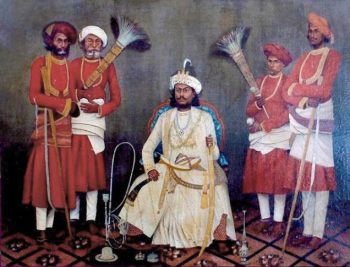India’s Africans – Siddis of Gujurat Posted by Nicole Herbert Dean on Sep 17, 2021 in Culture, History
Deep in the forests वन of Gujarat you will hear the sounds of African drums signaling a dance was occurring. As you walk in the direction of the sounds आवाज़ you will begin to see people that do not look like your average Gujarati. They do look more like people from across the Arabian Sea, going lower down the map into the Indian Ocean to the continent महाद्वीप of Africa. The Siddi Africans.
Their ancestral पैतृक lands maybe across oceans but they have retained their distinct culture. They dance to the beat of the drum mimicking the lions that live in the forest surrounding them. Their faces are painted with white paint with beautiful सुंदर designs as they dance around a bonfire. Their dress is a loose colorful fabric draped around their middle in skirt like fashion.
A brief history
India has so many flavors, colors and ethnicities. There are about 20 thousand Siddis living in the western state of Gujarat, India. They are descendants of Africans. Some scholars पंडित believe the Portuguese brought the Siddis to India, and some believe that centuries ago, Africans from Eritrea, Somalia and Ethiopia sailed to India as merchants. Some Africans were also brought over as slaves to work on the railroad as laborers मज़दूर or as bodyguards. The Siddis maintain that they were a group of elite slaves दास – serving the ruling kings only. They were picked and favored by Indian rulers, Mughals and nawabs because of their loyalty निष्ठा and their military skills. The nawabs also believed that the Siddis had special relationship skills with the lions in the forest.
Soon the Siddis rose to power themselves and ruled over city states in some cases escaping slavery. Some rose up the ranks to become admirals and generals because of their military prowess सैन्य कौशल.
Where are they today?
Many Siddis married Indians and started to integrate into Indian society. Some isolated पृथक करना themselves in small villages in parts of Gujarat in order to preserve their African identity.
Today they are considered a minority. They live in the fringes of society in utter poverty, establishing communities in the forested areas. They rarely finish school. Once military, laborers or royalty they are now cashing in on their culture संस्कृति by putting on dance shows for tourists. The fee to watch them dance in a nearby hotel will earn them 25 dollars which is about 15,00 Rupees. There are two or three seasons that are prime for tourists. They plan at least 6 hour long programs for each season.
They also work in the Gir Forest as guides for tourists पर्यटक or in the Indian army. There is a move by the Indian government to conserve the Asiatic lion सिंह . The Siddis play an integral अभिन्न role in this effort as they believe they cannot live without the lions.
The Indian government recognizes the Siddis as a tribe, since the fifties and have provided them with individual rights with special access to education and jobs. The Siddis also get government benefit भत्ता payments directly to their bank accounts.
The Siddis have no desire to go back to their ancestor’s country of origin मूल. Their wish is to live peaceably and die among the majestic Asiatic lions of the Gir Forest.

Build vocabulary, practice pronunciation, and more with Transparent Language Online. Available anytime, anywhere, on any device.




